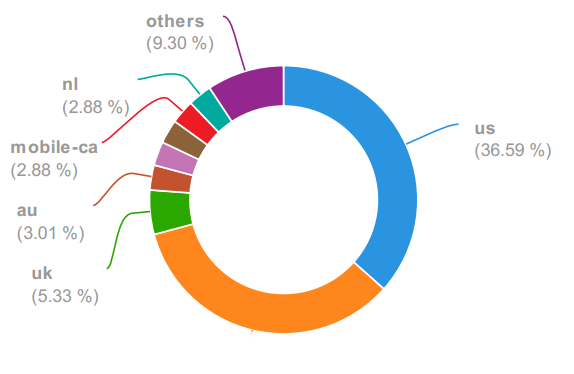
The landscape of online business promotion has changed radically over the last decade. Technology and the internet have led to the rapid expansion of digital marketing, which is now considered the preferred method of advertising for SMEs. In spite of this, about 49% of business owners have little to no positive results from their marketing efforts, as reported by Smart Insights.
While some of them grapple with limited resources, others are green as grass when it comes to sorting through tons of online info for effective strategies. There also are those who believe that the process is time-consuming, costly, and complicated. Such entrepreneurs need a helping hand, which is where this guide comes in.
Why is Digital Marketing Important?
Let’s face it. Many businesses have gone digital. The yellow pages are no longer the only resource for finding products and services. Online listings, search engines, and social media are now at the disposal of consumers who care to know more about any company’s identity, business model, and offerings.
While traditional methods like word of mouth and brochures might have once been the bee’s knees to building credibility and trust, such techniques are insufficient in the era of information overload. Little wonder digital marketing wields $521 billion in market value, eclipsing the gaming and cyber industries, and is projected to surpass $780 billion in 2026.
The past year alone has seen 63% of businesses increase their marketing budgets, which cements the fact that brand promotion via digital channels has become more of a norm than a luxury. Although a tough call for marketers and founders, effective marketing solutions aren’t an impossible feat.
What Key Benefits Do Small Businesses Stand to Gain?
Relationship building and engagement have never been easier, thanks to digital marketing. This promotional technique provides real-time tracking to determine suitable strategies for sales growth. Plus the benefits below are enough reasons for SMEs to embrace it.
- Compete more effectively against larger brands.
- Easy and instant tracking of consumer responses to marketing efforts.
- Target the right audience at the right time without breaking the bank.
- Identify one’s target audience’s needs, and personalize products and services to engage them and build loyal followers.
- Engage prospects at every stage of the buying process through communication.
- Absence of geographical limitations during outreach.
- Increase conversion rates to get a higher ROI.
The visibility and engagement challenges faced by SMEs are often formidable, especially in saturated industries, which is why digital marketing should be a prioritized tool in their arsenal. Still, the question remains: “What marketing strategies are worth implementing?”
Golden Secrets That Guarantee Small Business Owners a Win
There’s no shortcut to effective marketing. The key lies in knowing the reliable, affordable, and proven strategies industry leaders adopt, of which the following provide a springboard for small businesses:
Brand Storytelling
Trust and brand loyalty are two valuable assets SMEs look to gain. To make that happen, business owners are required to establish a compelling and cohesive narrative around their brands and offerings. The more personal and relatable their stories are, the easier it is to connect emotionally with consumers.
One company that stands out in this regard is Swedish furniture giant IKEA. The multi-billion-dollar conglomerate recreates modish and interesting pieces from banal household items to engage the everyday buyer. A testament to this is its Shelf Help Guru campaign, a “shelf discovery” adventure for bathroom and bedroom improvements.
Rather than focus on features, industry leaders sell experiences through brand storytelling.
Marketing Automation
Automated processes streamline marketing efforts at various stages of a customer’s journey with a company. With this strategy, tedious tasks that are crucial to daily operations, such as email marketing and SM campaigns are cut down to improve efficiency. It’s easy to track engagement, establish follow-ups, and interpret buyers’ online footprints.
Studies show that 51% of companies use this technology and 58% of B2B companies plan to adopt it, making it a highly sought-after trend in the industry. Marketers are no exception as they can get 33% lower costs per lead and 50% sales leads.
Google My Business (GMB) Listing Creation
Companies looking to maximize their digital footprint should consider GMB listings. The process entails creating an optimized profile on Google My Business, a free online tool with which business owners can list their addresses, contacts, and other information to help nearby prospects find them online.
About 1.5 billion monthly visits are linked to several websites and pages based on Google SERPs. Furthermore, 76% of searches nearby result in a visit or a phone call within a day. A business listed on Google Maps has a good chance of being seen, which implies more engagement and revenue. Besides, GMB listings build credibility and SEO ranking.
Website Optimization for Mobile Use
More people access the internet through mobile devices than desktop computers. In the U.S. alone, smartphones and tablets account for 63% of all internet traffic, and it only goes up from here. Therefore, mobile optimization is more crucial than ever to capture a broader audience.
Non-mobile-friendly business sites are easily ignored, which means fewer visitors, as well as low engagement and conversion rates. For a website to be mobile-friendly, it should be responsive and easy to navigate. That way, visitors have no problem browsing through your offers, regardless of the device they use.
Influencer Marketing
Social proof is important to consumers, and in some cases, reviews from strangers are not enough to influence their purchases. This is where influencer marketing comes in, as it is a less invasive way for brands to convince prospective buyers. Based on a 2019 Rakuten advertising study, 87% of shoppers attributed their purchases to influencer marketing.
Despite being valued at over $16 billion, this tool is easy on the pocket for small businesses in need of recommendations and engagements. It comes down to finding a natural fit for one’s brand. Followers generally trust endorsements from familiar public figures. The latter, understanding the target market and connecting with the brand, become invaluable allies in driving traffic and generating revenue.
An excellent case in point isJack Daniel’s “Make It Count” campaign, launched in 2020 to commemorate its 154-year history. It featured Hardy Caprio and Lost Girl, two of the UK’s top-rated artists, making it a huge success.
Customer Service
There’s no better marketing strategy than happy customers who are eager to recommend a business. Informed decisions are now easier to make with the help of review sites, and for that reason and more, excellent customer satisfaction is paramount. This strategy doesn’t cost a dime to implement, as existing employees can learn to handle customers’ inquiries and issues promptly and courteously, ensuring they get the best experience.
Personalized Email Marketing
Businesses are expected to be in constant touch with their customers, but an impersonal approach is no longer effective. To stand out from the crowd, email marketing campaigns should be tailored to suit the needs of different market segments. This requires a bit of strategy, which when done correctly, can help acquire and retain customers.
One strategy is building targeted marketing lists. If a business sells different products and services to consumers from different backgrounds and demographics, the emails sent out should align with each audience’s needs and expectations.
Social Media Posts (Paid and Organic)
As with content marketing, paid social media marketing enables companies to engage with their target market on a much more personal level. Social media platforms, such as Twitter, Facebook, and Instagram, create avenues for brands to push their content to the public either through paid promotions or organic reach.
Each approach has its merits and demerits with regard to demographic, competition, time, budget, algorithm, flexibility, reach, and results. The choice to use one or both depends on the needs of the business, which poses no problem since 93% of marketers worldwide use this strategy.
Google Paid Ads
Search engine results pages (SERPs) are now inundated with paid adverts, particularly on popular shopping days, seasons, or holidays. With Google Ads for PPC (Pay-Per-Click) championing 80% of trades globally, it’s only ideal that SMEs leverage this platform to propel their websites to the top of search engine rankings.
The process entails creating an ad that captures the prospects’ interest. It should feature keywords relevant to the products and services to ensure an enhanced organic reach. This ensures a broader market of engaged consumers, bound to translate into more conversions. Google paid ads are flexible as they allow for testing and analysis to get the most out of every dollar spent.
Local Marketing
Unlike the conventional outbound and inbound marketing strategies, local marketing is based on what local consumers want. It has a higher chance of success since it caters to the unique needs and interests of potential buyers within a local community, who may not have known of abrand’s product or service.
This strategy centres on building an online presence by listingthebrand on local business directories, like Yelp or Bing, to improve online visibility. Businesses are also encouraged to use local search phrases (which is the bedrock of effective local SEO) in their websites and ads to increase online traffic.
Direct mail campaigns and community events, such as conferences and workshops, are also powerful tools for building brand awareness in a specific locality. Active players can tap on the power of partnerships and alliances to gain additional exposure for their offerings.
Related article: How Much Does SEO Services Cost for Small Businesses?
Blog Creation
Small and large-scale companies, from Coschedule to Walmart, partly owe their success to their evergreen blogs that provide valuable insights on subjects relevant to their audience. Blog posts don’t only boost SEO ranking, but also create inbound leads from interested prospects who seek additional information.
Some businesses avoid blogging as it takes time and effort to publish high-quality articles. It also requires constant creativity and discipline to stay ahead of the curve. But then, there is always room to outsource the writing to a seasoned blog agency. According to research, businesses that use blogs achieve 55% more website visits and 126% more lead growth.
Online Reviews
Positive reviews on a business website, Facebook page, and Google business page are not only a sign of excellent customer experience but also increase conversion rates. In fact, 72% of consumers trust a brand more when it has positive reviews. For this reason, small business owners should encourage online reviews from satisfied customers.
One way is to offer them a small discount or a complimentary product with every review they leave. That way, they’ll feel an added obligation to leave positive reviews. Another strategy is to use customer feedback to improve products and services so that they meet or surpass their expectations.
Local Newspaper Ads
These days, most consumers prefer reading the news on mobile devices. But when it comes to small businesses, newspapers are still relevant for two reasons. First, a local paper has a wide reach, making it easier for a brand to penetrate an audience that has long been out of its reach.
In addition, the credibility of a newspaper makes it easy for consumers to trust its content. Small business owners may choose from a wide range of advertising options that fit almost any budget.
Press Release Distribution
A newsworthy release can go a long way in attracting attention to a business. This piece of content may focus on an event, launch, product, general news, or position statement. Since it promotes a brand or message, it can be distributed to land coverage in local newspapers, TV, or radio stations.
The number of backlinks from credible sites drives higher search engine ranking, which increases visibility and generates inbound traffic. About 72% of journalists rely on press releases for stories, which shows that it is still an effective tool for brand awareness and growth.
Conclusion
Digital marketing isn’t a fad; it’s a powerful promotional tool that can help SMEs compete with the bigger players in the industry. The secret to achieving mind-blowing results with this solution is to have the right combination of marketing strategies that identify target audiences, their location, and the best ways to engage them. What’s more, these strategies are affordable, easy to implement, and effective in converting prospects to loyal customers.
Contact WeSEOexperts for a digital marketing plan for your small business.



